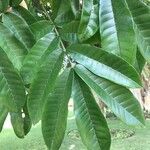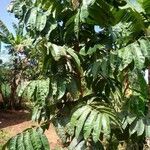Evergreen tree up to 20 m tall; bole up to 1.8 m diam., tall and straight when growing inside forest, but branched at 2 m in open; crown dense, very wide-spreading in open. Leaves up to 260 mm long. Leaflets 7-11, up to 210 x 85 mm; apex of lateral leaflets shortly and acutely acuminate or bluntly subacuminate (with the tip itself often shallowly notched), nearly always showing a hollow curve; lower surface glabrous or with a few short strigulose hairs, usually drying dark brown; lateral nerves in 7-12, usually widely spaced pairs. Inflorescence sometimes many-flowered in male, always few-flowered and usually in female. Petals usually 13-22 mm long. Staminal tube usually 10-16 mm long. Fruit (ripe but unopened) 30-50 mm in diam., occurring 1-3 together in the leaf axils.
Evergreen tree, 2-15 m high; crown dense, wide spreading; apparently dioecious. Leaves imparipinnate; leaflets 7-11, entire, apices shortly acuminate, lateral nerves 7-12 in widely spaced pairs. Flowers in cymose panicles. Calyx 5-lobed. Petals 5, imbricate. Staminal tube with 10 stamens; filaments connate in lower half, free portion often densely villous, with a pair of lateral appendages at apex. Flowering time midsummer. Fruit a coriaceous capsule, 2-4-locular, up to 50 mm in diam., without a stipe or an indistinct stipe up to 3 mm long. Seeds 1 or 2 per locule, large.
A very large tree. It grows up to 30 m tall. The bark is grey and smooth. The trunk can have small buttresses. The leaves are made up of 3-4 pairs of leaflets and a leaflet at the end. The leaflets are 21 cm long by 8.5 cm wide. They are dark glossy green above. The flowers are large and creamy-white. The petals are up to 2.4 cm long. They occur in short branched sprays in the axils of leaves. These are 5 cm long. The fruit is an almost round creamy-brown capsule. It is 3 cm across. It splits into 3-4 valves. The seeds are black and covered by a red seed coat (aril).
Leaves imparipinnate; petiole and rhachis up to 26 cm. long, glabrous or densely pilose; leaflets up to 21 × 8·5 cm., opposite or alternate, (2) 3–4 (5)-jugate, obovate to oblanceolate or oblanceolate-elliptic, nearly always distinctly broadest near the apex, apex nearly always acute or acuminate, rarely rounded or emarginate, base rounded or cuneate, upper surface drying dark brown, lateral nerves in 8–9 (12) pairs, lower surface glabrous or with a few strigose hairs, very rarely sparsely to densely pilose; petiolules up to 1 cm. long.
Filaments usually 1–1·5 cm. long, united for about half their length, sparsely puberulous outside, densely villous in the upper half inside. Appendages deltate, nearly 3/4 as long as the anthers; anthers 2 mm. long, slightly apiculate, antherodes a little smaller, not producing pollen.
Ovary 3 (4)-locular; style usually 8–10 mm. long, columnar, densely setulose-puberulous almost to the apex; stylehead capitate, with a crateriform apical (?)stigmatic region.
Evergreen tree, up to 20 m high. Leaflets 7-11, up to 210 x 85 mm. Capsule without a stipe or with an indistinct stipe up to 3 mm long. Flowers greenish cream.
Capsule c. 3 × 3 cm., obovoid-globose, without a stipe, slightly sulcate, surface transversely wrinkled, fulvous-tomentellous, opening by 3 (4) valves.
Large evergreen tree 25–40 m. tall; bole slightly buttressed, up to 2 m. in diam.; bark grey and smooth like a Ficus.
Calyx usually 5–7 mm. long, strigulose-tomentellous, lobed to half-way or more, lobes subcircular, imbricate.
Petals (1·3) 1·4–2·4 (2·6) cm. long, linear, tomentellous on both surfaces.
Disk glabrous, thin, with 10 deltate teeth alternating with the filaments.
Seed black, almost completely concealed by the scarlet aril.
Flowers dirty white, in axillary cymes or cymose panicles.
Pistillode with vestigial ovules.
Pedicels up to 1 cm. long.



